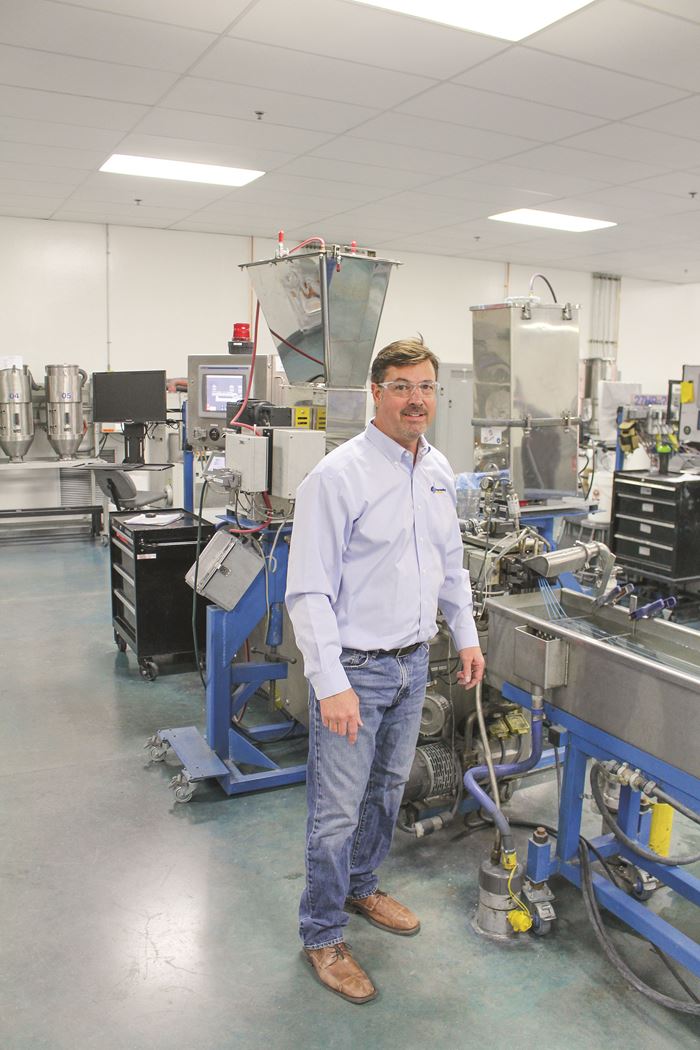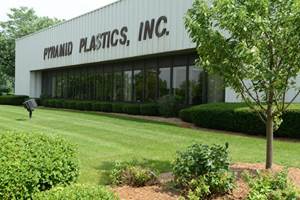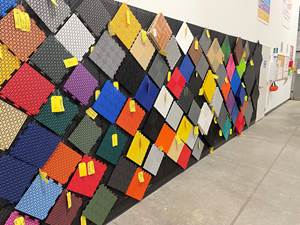If Scott Neal was born with a spoon in his mouth, it was probably plastic. In 1980, at the age of 10, he was running his first extruder. His father, Robert Neal, was a long-time entrepreneur in plastics, and at the time owned Maine Poly Inc., which processed blown and cast film for food and electronics packaging.
In 1990, armed with a degree in economics and business from the University of New Hampshire’s Whittemore School of Business and Economics, 22-yr-old Scott, like his dad before him, decided to strike out on his own. He founded PolyColors Inc. in Lewiston, Maine, a compounder of custom color masterbatch serving Northeast blown film, injection molding, and profile extrusion processors. Seven years later, the younger Neal sold his business to Clariant Masterbatches.
After staying on as general manager, Neal’s entrepreneurial genes kicked in again. He resigned from Clariant in May of 1999 and founded Compounding Solutions LLC, also in Lewiston with, he recalls, “two extruders, three employees, and 8000 ft2 of space.” Though armed with expertise in color matching, formulating and compounding, a non-compete clause precluded Neal’s new company from entering that business, so—owing to the preponderance of medical OEMs in the Northeast—Neal steered Compounding Solutions to the medical market. By 2004, he had expanded its plant to 20,000 ft2, added a third extrusion line, and grown to 20 employees.
“When Compounding Solutions was started, there were a lot fewer shoot-and-ship, general-purpose molders in the area than there were just 10 years before,” states Neal. “At the same time, we saw the medical market as up-and-coming. And we identified a need among medical-device companies for consistent, high-quality compounds. That’s a need we sought to fill.”
Today, Compounding Solutions is certified to ISO 9001:2008 and ISO 13485 and sells globally. It runs 14 twin-screw, co-rotating extrusion lines (12 for production, two for R&D) ranging in size from 18 to 50 mm and supplied mostly by Leistritz, Somerville, N.J. The company has expanded its plant to 60,000 ft2 and at the time of Plastics Technology’s visit was putting the finishing touches on a 60,000 ft2 expansion.
That expansion—a brand-new building adjacent to Compounding Solutions’ existing plant—frees up space for up to 10-12 more compounding lines, says Neal. “We will not be moving any equipment from the existing plant to the new one,” he states.
“At first, we’ll be using most of the space for warehousing.” That said, one new 50-mm line is on order and due to arrive in June; it will be the first line installed in the expansion. The new building will have a 6400-ft2, Class 100,000 clean room, expanding Compounding Solutions’ ability to create materials with active pharmaceutical ingredients to produce drug-eluting compounds.
Neal is also investigating an entry into the pharmaceutical compounding market. The new building will feature a 3200-ft2, controlled-environment white room for fluoropolymer compounding; and an 8000-ft2 area for industrial compounding.
The expansion includes plans for two new silos, each with 80,000 lb of capacity. The medical-device industry accounts for roughly 75% of the compounder’s revenue. “Our business has been mostly medical for the past 10 years,” says Neal. “It’s not our intention to be 100% medical.
We supply compounds to processors in food packaging, footwear, sporting/consumer goods, 3D printing, automotive, and others. We even provide toll compounding services. But we’re comfortable with medical representing 75% of what we do and tend to focus our marketing and product-development efforts in that area.”
On a volume basis, Compounding Solutions runs about 5 million lb/yr. While not comfortable revealing annual sales numbers, Neal divulged that the company has grown by 20% for 12 straight years.
FOCUS: TECHNOLOGY
Neal says his client list among medical-device firms includes all the major OEMs. In many cases, material is specified by the OEM, which then directs the compound to be shipped to the molder or extruder for processing. “We may sell to the OEM most often but stay very close to the processors,” Neal explains. “We need to know the problems the processor is dealing with in order to solve them.” Neal estimates that about 40% of the material he sells into medical is used in production of catheters.
Compounding Solutions runs a full slate of materials, including polyolefins, styrenics, polyesters, PC, nylons TPUs, biodegradables. TPEs, and fluoropolymers. It also supplies a range of high-heat compounds and considers PEEK a specialty, while noting that TPU and TPE (notably PEBA) compounds now represent its biggest growth areas.
Nowadays in particular, with engineering resources at a premium, a lot of compounders rely on their extruder supplier to specify all upstream and downstream components and supply them with a system in a package. Not so for Compounding Solutions: It buys the extruder—paying careful attention to specifying screw design and metallurgy, as well as the controls platform—and all upstream and downstream machinery, and integrates the equipment on its own. That includes desiccant dryers, loss-in-weight feeders, and strand and underwater pelletizers.
“We are very comfortable in our technical knowledge of twinscrew extruders,” says Neal, who bought his first Leistritz machine, a counter-rotating twin, while running PolyColors. “We’ve made it our mission to understand a lot about design and placement of screw elements. In fact, I think we are at the forefront in the development of high-dispersion radiopaque compounds, and a lot of that know-how came from our experience in color dispersion.
The compounder has two manufacturing areas in its current 60,000-ft2 footprint: one for industrial products and a separate white room specifically for medical products that is furnished with seven extrusion lines—six twins and one single-screw extruder.
Its 7600-ft2 white room includes an air lock with a positive-pressure environment, sealed and polished concrete floors, a HEPA-filtered air exchange with humidity and temperature controls, and epoxy-coated wall surfaces to repel dust and allow for easy cleaning of all surfaces. Neal says that temperature and humidity control offer substantial benefits for processing conditions, depending on the time of year. “Urethane materials always appreciate the venue due to it is low water-vapor content,” he elaborates. “Similar hygroscopic materials are always a challenge to process under high-humidity conditions. The white room provides a step far above typical environmental conditions to further assist with effective processing.”
The walls and floors are all sealed and polished so that in the event of contamination the room can be washed from top to bottom. Feeders are all covered and sealed under nitrogen to ensure that nothing is getting into the compound other than what’s specified. Downstream of the water baths, changing the water and scrubbing the tanks is standard practice to minimize the number of pyrogens contacting the strands before they are cut and bagged.
White-room compounding is not an industry standard by any means, Neal states. “Unlike other compounding companies, we built our company from the ground up as a medical supplier rather than backing into the market as a side thought.”
“The only real differences between our white room and a clean room are the certifications associated with the label,” he adds. He says that roughly 90% of the compounds he develops include color, and notes that obtaining and maintaining clean-room certification would be “extraordinarily challenging” due to the extremely fine particle sizes of most colorants and even some radio-opacifiers. “But we do conduct our own air-quality reviews and have found that we meet Class 100,000 standards,” Neal notes. “Due to the costs involved in maintaining that level, we have chosen to not take a certification. We believe customers appreciate the savings it passes along as well as the cleanliness of their products without undue extra costs.”
Neal notes that the compounder will also dry and package materials with a nitrogen blanket, so they can be dropped into a customer’s molding or extrusion machine without requiring preconditioning. Leaving no stone unturned, the company packages its materials in plastic pails with sealed lids rather than more typical cardboard boxes, which can generate particulates. “We go the extra mile for both our products and our customers,” is how Neal puts it. “Cleanliness and housekeeping are huge considerations when serving the medical market. We always stay on top of those.”
Throughout the plant, production runs are scheduled based on extruder screw design. Compounding Solutions’ average order is 2000 lb; it runs orders anywhere from 25 to 100,000 lb. “Most compounders have 100-lb minimums, but we go down to 25 lb, which in some medical applications can be a year’s supply.
“The white room provides a step far above typical environmental conditions to further assist fith effective processing.”
Every compound the company makes has a paper trail, a physical file that Compounding Solutions keeps on record after the material has been formulated. The compounder has run sheets stored digitally on its control system so operators can access processing parameters on any product. During Plastics Technology’s visit, the firm was in the process of equipping each of its whiteroom extrusion lines with more advanced production-monitoring controls that will allow it to capture screen shots of process information in real time.
Compounding Solutions’ manufacturing operations are supported by a mechanical room, where the company houses its central chilling and nitrogen units and builds its own dies. It also has an in-house team of six dedicated to maintenance. Nearby, the company keeps batch blenders for offline mixing of up to 2000-lb lots, screw-cleaning machines that use blasting media, and ovens for predrying fillers and antimicrobials. It also has a large drum of mineral oil, used for elastomer compounds.
R&D LAB GETS A BOOST
In 2016, Compounding Solutions expanded its R&D efforts with a 2000-ft2 center—named after long-time employee Pete Goguen—equipped with both production- and lab-sized twinscrew compounding lines; a single-screw extruder; three injection molding machines; a two-roll mill; and dryers and ovens. As Neal explains it, the company works regularly on developing new formulations and processes across all its markets. As an example of the latter, the company developed a reactive extrusion process for compounding a hot-melt adhesive that had been blocking. On another occasion, it developed a proprietary process that allowed for inclusion of weight-reducing hollow glass beads into the compound at high loadings without glass breakage.
Sometimes the company will even engineer its own equipment to solve a problem. On one occasion, it was running a polymer that was hypersensitive to oxygen and water, so it designed a vacuum enclosure that surrounded the polymer in the feed area, pelletizer, and packaging line to keep oxygen and water away from the material.
In the lab, Compounding Solutions has the full gamut of equipment for mechanical, physical, impact, rheological, and visual testing. Says Neal: “We embrace technology, and we use it in a way that gives us a quality advantage in the compounds we produce, the speed at which we develop and produce them, and the service we offer customers.”
Related Content
Pyramid’s Relentless Pursuit of Quality
Instilling a culture of quality, and the ability to offer tooling from a sister company, are pushing Pyramid Plastics to new heights.
Read MoreUS Merchants Makes its Mark in Injection Molding
In less than a decade in injection molding, US Merchants has acquired hundreds of machines spread across facilities in California, Texas, Virginia and Arizona, with even more growth coming.
Read MoreInjection Molder Bases Company Culture on Employee Empowerment
After more than two decades in the industry, Rodney Davenport was given the opportunity to create an injection molding operation in his own vision, and — in keeping with the product he was making — to do so from the ground up.
Read MoreInside the Florida Recycler Gearing Up to Take on Scrap at NPE2024
Hundreds of tons of demonstration products will be created at NPE2024 next spring. Commercial Plastics Recycling strives to recycle all of it.
Read MoreRead Next
Advanced Recycling: Beyond Pyrolysis
Consumer-product brand owners increasingly see advanced chemical recycling as a necessary complement to mechanical recycling if they are to meet ambitious goals for a circular economy in the next decade. Dozens of technology providers are developing new technologies to overcome the limitations of existing pyrolysis methods and to commercialize various alternative approaches to chemical recycling of plastics.
Read MoreUnderstanding Melting in Single-Screw Extruders
You can better visualize the melting process by “flipping” the observation point so that the barrel appears to be turning clockwise around a stationary screw.
Read More
























.png;maxWidth=300;quality=90)







